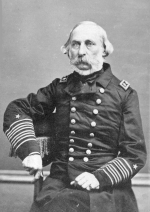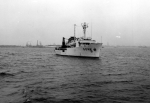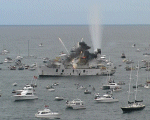Click On Image
For Full Size Image |
Size |
Image Description |
Source |
 USNS Charles H. Davis (T-AGOR-5) USNS Charles H. Davis (T-AGOR-5)
|
 |
222k |
Namesake
Charles Henry Davis (January 16, 1807 – February 18, 1877) was a Rear Admiral in the United States Navy, serving primarily during the American Civil War and with the United States Coast Survey. He was commissioned as a Midshipman on August 12, 1823. Between 1827 and 1828, he served on board the frigate the USS United States, in the Pacific. In 1829, he was promoted to Passed Midshipman. From 1830 to 1833, he served on the sloop the USS Ontario. In 1834, he was promoted to Lieutenant and assigned to the USS Vincennes. In 1840 to 1841, he served on board the USS Independence. From 1846 to 1849, he worked in the United States Coast Survey on board the USS Nantucket, where he discovered a previously unknown shoal that had caused shipwrecks off the coast of New York. During his service to the Survey, he was also responsible for researching tides and currents and acted as an inspector on a number of naval shipyards. In 1854, he was promoted to Commander and given the command of the USS St. Mary's. In 1859, while commanding the St. Mary's, Davis was ordered to go to Baker's Island to obtain samples of guano, becoming perhaps the first American to set foot there since it was annexed by the United States in 1857. The guano was necessary as fertilizer. Commodore William Mervine had previously been sent, but he did not land and believed the island to be inaccessible. (From evidence that was later found on the island, it had been visited prior to 1857 by whalers.)
In 1861, he was promoted to Captain. In the American Civil War, he was given command of the Mississippi Flotilla and fought a short battle with Confederate ships near Fort Pillow on May 11, 1862. Three of their eight attacking ships were disabled with only minor damage to one of the defending Union ships. On June 8, he fought in the Battle of Memphis, resulting in Davis delivering the demand to surrender (which was accepted) to the troops there. In July, he fought in the Battle of Vicksburg, but was forced to withdraw. (At this time, he was also promoted to Commodore.) In August, he proceeded up the Yazoo River and successfully seized Confederate supplies and munitions there. After this excursion, he was made Chief of the Bureau of Navigation and returned to Washington, D.C.. On February 7, 1863, he was promoted to Rear Admiral. From 1865 to 1867, he was the Superintendent of the United States Naval Observatory. In 1867, he was given command of the South Atlantic squadron and was given the USS Guerriere as his flagship. In 1869, he returned home and served both on the Lighthouse Board as well as in the Naval Observatory.
Several ships of the United States Navy are also named in his honor: the torpedo boat Davis (TB-12) and the destroyers Davis (DD-65) and USS Davis (DD-395).
Digital ID: cph 3c04940 Source: Library of Congress |
Bill Gonyo |
 |
69k |
USNS Charles H. Davis (T-AGOR-5) launching, 30 June 1962, at Christy Corp, Sturgeon Bay, WI.
US Navy photo from DANFS. |
Joe Radigan MACM USN Ret. |
 |
99k |
USNS Charles H. Davis (T-AGOR-5) underway in Boston Harbor, 30 January 1963, five days after being placed in service.
Boston Naval Shipyard photo ASF #876, Boston National Historical Park Collection, NPS Cat. No. BOSTS-10659 |
Stephen P. Carlson, Preservation Specialist, Boston NHP, Charlestown Navy Yard, Boston, MA. |
 |
91k |
USNS Charles H. Davis (T-AGOR-5) underway, circa 1964, location unknown.
US Navy photo. |
Robert Hurst |
 HMNZS Tui (A5) HMNZS Tui (A5)
|
 |
29k |
Ex-HMNZS Tui (ex Charles H. Davis) being sunk as an artificial reef at Tutukaka NZ, 20 February 1999. |
Photo courtesy Dive Tutukaka web site |
 |
29k |
Ex-HMNZS Tui (ex Charles H Davis) sinking at Tutukaka NZ, 20 February 1999. |
Photo courtesy
RNZN New "Navy Today" |







